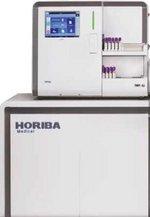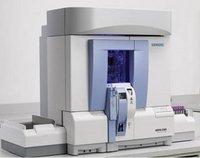

► Click here to download the original poster (PDF)
Lena Bielawska1, Grażyna Kasprzak1, Natalia Urbańska2, Krzysztof Lewandowski3, Danuta Haertle4, Ewa Wysocka1
1 Department of Laboratory Diagnostics, Poznan University of Medical Science, Poland
2 University Hospital of Lord's Transfiguration of Poznan University of Medical Sciences, Poland
3 Department of Hematology and Stem Cell Transplantation, Poznan University of Medical Sciences, Poland
4 HORIBA Medical, Warsaw, Poland
Measurement technologies used in hematology analyzers have undergone continuous improvement, which has been mainly associated with the development of various flow cytometry techniques. Leukocytes are differentiated into subpopulations basing on cell volume as well as their size and complexity of the nucleus. Basic measurement technologies are supported by application of specific cytochemical reactions. The combination is to provide a high sensitivity and specificity of the determinations. Differential analysis of leukocytes in hematology analyzers is an important contribution to clinical practice. The aim of the study was to evaluate the analytical efficiency of new methodological solutions, used in hematology analyzer Yumizen H2500, compared with the ADVIA 2120i in the assessment of peripheral complete cell blood count (CBC) in difficult clinical situation, which is hematological oncology.
In 254 patients with hematological oncology diseases (126 women and 128 men; aged 25 to 84 years), in the same venous blood sample, CBC determinations using two hematology analyzers were performed in parallel. Statistical analysis was performed using Statistica 10.0 version, taking into consideration the whole study population and 4 subgroups characterized by leukocytes count (WBC): WBC <1,00 x109/L; WBC 1,00-3,99 x109/L; WBC 4,00- 10,00 x109/L, WBC >10,00 x109/L.
Complete or almost complete correlations for routine CBC parameters were obtained from the two analyzers (RBC r=0,989, HGB r=0,998, HCT r=0,980, MCV r=0,928, PLT r=0,994, WBC r=0,997, Neu r=0,988, Lym r=0,998) in the whole study population. Among them in 35 patients, who were ordered Reticulocyte count, the correlation r=0,948 was observed. WBC, Neutrocytes, Lymphocytes continued very high coefficient of correlation in subgroups, excluding WBC <1,00 x109/L group. The best relationships were observed for Monocytes (r=0,913), Eosinocytes (r=0,968) and Basocytes (r=0,765) when WBC 1,00-3,99 x109/L. Extended differential parameters of Yumizen H2500, especially IMM (Immature Monocytic cells absolute value), IMG (Immature Granulocytic cells absolute value) and IML (Immature Lymphocytic cells absolute value) presented high/very high correlation to Advia 2120i Monocytic cell count, if regular relationships between Monocytes decreased in WBC <1,00 x109/L and WBC >10,00 x109/L groups.
Table 1: Brief characteristics of analyzers: Yumizen H2500 and Advia2120i
Yumizen H2500 | ADVIA 2120i | |
| Parameters | CBC + 5 DIFF + RETIC | CBC + 5 DIFF + RETIC |
| Technology | optical + impedance | optical + cytochemical reaction |
| Efficiency (Throughput) | 120 samples/hour | 120 samples/hour |
| Blood sample volume | 110 μl | 175 μl |
| Operating mode | Manual and automatic - closed tube + autosampler | Manual and automatic - open or closed tube + autosampler |
| Weight | 112 kg | 193 kg |
Table 2: Correlation of routine CBC parameters and WBC differential – in whole population and subgroups
| The whole population n=254 | WBC <1,00 x109/L n=29 | WBC 1,00-3,99 x109/L n=53 | WBC 4,00-10,00 x109/L n=118 | WBC >10 x109/L n=54 | |
| RBC [x1012/L] | 0,989 | 0,938 | 0,981 | 0,988 | 0,987 |
| HGB [mmol/L] | 0,998 | 0,994 | 0,998 | 0,997 | 0,998 |
| HCT [L/L] | 0,980 | 0,857 | 0,971 | 0,983 | 0,969 |
| MCV [fL] | 0,928 | 0,641 | 0,969 | 0,950 | 0,879 |
| PLT [x109/L] | 0,994 | 0,985 | 0,994 | 0,991 | 0,995 |
| WBC [x109/L] | 0,997 | 0,892 | 0,980 | 0,937 | 0,999 |
| Neu [x109/L] | 0,988 | 0,864 | 0,942 | 0,927 | 0,985 |
| Lym [x109/L] | 0,998 | 0,863 | 0,983 | 0,978 | 0,997 |
| Mono [x109/L] | 0,168 | 0,583 | 0,913 | 0,723 | 0,042 |
| Eos [x109/L] | 0,839 | 0,962 | 0,968 | 0,462 | 0,935 |
| Baso [x109/L] | 0,654 | 0,444 | 0,765 | 0,568 | 0,630 |
| LUC/LIC [x109/L] | 0,552 | 0,241 | -- | -- | 0,497 |
| A-Mono-& Y-LIC | 0,917 | 0,600 | -- | 0,250 | 0,933 |
| A-Mono & IMM | 0,932 | 0,640 | -- | 0,264 | 0,937 |
| A-Mono & IMG | 0,820 | 0,254 | -- | 0,187 | 0,868 |
| A-Mono & IML | 0,761 | -- | -- | 0,003 | 0,743 |
White blood cell differentiation could be an important challenge in specific hematology disorders and microscopy of peripheral blood smear remains the method of choice. However, the different immature leukocyte absolute value could improve the laboratory and clinical practice in the extreme white blood cell value patients.
Do you have any questions or requests? Use this form to contact our specialists.